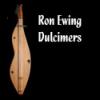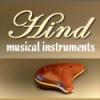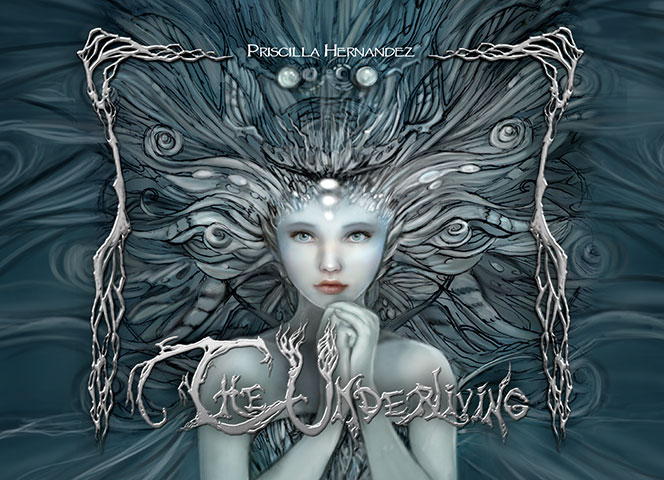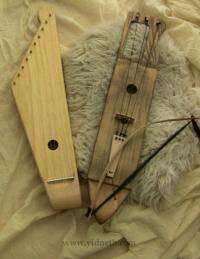The finnish Jouhikko or Bowed Lyre
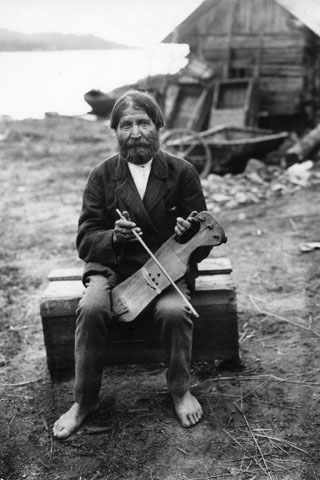
Feodor Pratšu playing Jouhikko © Museovirasto
Jouhikko (pronounced yo-hee-ko) is the name given to a distinctively type of bowed lyre from Finland and Karelia (an instrument old as human civilisation itself) though it resembles in some ways types of Baltic Psaltery from further east such as the Slav Gusli, and types of psaltery/lyre hybrids found in the archaeological record from Novgorod, Opole etc. It may be descended from these instruments rather than from the Round Lyre, strictly speaking this would make it a bowed psaltery rather than a bowed lyre, but whether a psaltery with a hand hole should be re-categorised as a lyre is a matter for musicologists... The origins of the jouhikko remains still a bit obscure, though obviously ancient.mPerhaps the earliest definite depiction of this kind of instrument is the stone carving from Trondheim Cathedral, Norway, dating from the second quarter of the 14th century Jouhikkos are usually strung with horsehair string,
It is related with the Finnish instrument Kantele that we previously covered in another CMI article.
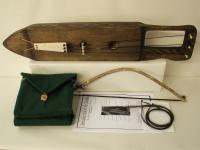
Above: Alto jouhikko kit available at Ancient music (UK)
I have myself an alto Jouhikko I purchased from Kate and Corwen from Ancient Instruments (UK) -by the way very talented couple themselves- and by far the most affordable source for the quality of the instrument. As a lover of the kantele the jouhikko makes an excellent couple to this other instrument being partners in many pieces of finnish music. This is a video of Corwen himself explaining a bit of the instrument:
Learning to play it:
First you need to hold the instrument upright between the knees. The typical Jouhikko has a long, narrow outline, with only a small hand hole which is offset to one side, allowing only one of the three strings to be stopped. There are Jouhikkos with two strings only but they normally have three being the middle string is a drone, the string furthest from the hand hole is used to play the first note of the scale.
The bow need to be moved parallel to the bridge and trying always to bow the drone sting and bass or melody string in a sort of of bouncing movement. The jouhikko only has a range of six notes. You can change the note by stopping with the back of your fingers (traditional way) or with the inside of the fingers if you place your handover the first string (melody) in order to be able to change the drone with the knucles (for intermediate players). It takes some time and practise to play the notes relaibly in tune, and also the instrument tend to come out of tune quite easily, so it helps that you have a good ear and get fast enough with the microtuners (a recommendation if you purchase this instrument)
Most Jouhikkos are in D key (with a tuning of D - A - E (being D the bass, A the drone and E second note on the scale). In alto jouhikko (A - E - B) You can play typically a major and minor scale. As you can see in the following video showing you the basics of how to play the jouhikko by performer Pekko Käppi.
Above: Video explaining how to play scales in the jouhikko
If you purchase it from Ancient Music , it comes with a little print brochure in english called "introduction to the Jouhikko" written in english with the basics to keep and start to play your instrument. Though brief, it´s consistent and carry quite a lot of information and background.
The actual reference to learn to play this instrument is The Bowed Lyre Book is a visual guide and tutorial book written by Rauno Nieminen
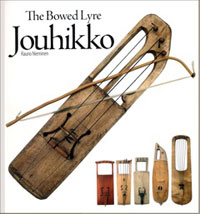
Above: Book: The Bowed Lyre Jouhikko
Written in Finnish on one side and clear English on the other. The book has the history, playing and setting up guide for the It includes a cd of rare archive recordings of the last players of the old tradition in Estonia, recorded on wax cylinder/phongraphs, though old and scratchy in sound in combination with the included written notation it provides much information.The book is available from Finland through the Finnish Music institute (37 Eur + shipping) or you can read more info from Rauno's website:
http://raunonieminen.com/sivusto/
For beginners (as myself) I also highly recommend to visit this Jouhikko website, though it's in finnish you can easily use an online translator, and it has even some videos and lessons of basic traditional jouhikko music as example, as well as explanations about the history and the instrument parts and construction. You can even play "online" the jouhikko in the website interface :) to understand how it works and videos to play the same melody in different styles with examples.

Above: How to hold the jouhikko bow (explained this jouhikko website). You can add a bit of pressure with the thumb to make the string of the bow tighter. Remember always to put rosin on your bow before playing (to avoid scratchy sound)
I confess I never had experience with bowed string instruments before... and I did know it was going to be complicated but though it's quite difficult to evolve fast (at least for me) it's rather easy to get started and this is quite encouraging. Gerry Henkel from kantele.com that also had made some jouhikkos himself told me... that they are like a horse that need some taming and that the jouhikko finally decides to sing for you itself. And he's right. There´s something really ancient and earthy and and primitive n the way these horse strings sound somehow rather dense like a rudimentary viola. Nothing as clean and polished as a violin but indeed a sound of other times settling in nordic folk music.
Jouhikkos are in the midst of a potent revival in Finland and is being incorporated in modern bands as well (including me LOL!)
You can read more information in the Jouhikko wikipedia article
- Finnish site about the Jouhikko
- Jouhiorkesteri
- Finnish Jouhikko maker
- Estonian Jouhikko maker
- Eric and Corwen English Jouhikko maker
- Russian Jouhikko maker
- More info on Simon Chadwick's Jouhikko with photos, audio and video demonstration
- Rauno Nieminen's official website
Above: My kantele (made by kantele.com) and my alto Jouhikko (It works well tuning it to G, A or Bb Key) (from Corwen Ancient Instruments) , a pretty couple of traditional finnish instruments. High D jouhikkos are the most commonly found.
- Login to post comments


